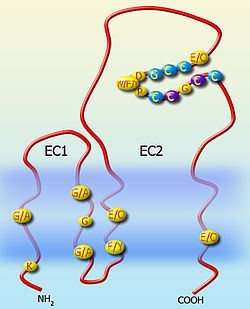Symbol Tetraspanin Pfam clan CL0347 PROSITE PDOC00371 | Pfam PF00335 InterPro IPR000301 SCOP 1iv5 | |
 | ||
The first complete molecular structure of a tetraspanin a family of elusive proteins
Tetraspanins are a family of membrane proteins found in all multicellular eukaryotes.
Contents
- The first complete molecular structure of a tetraspanin a family of elusive proteins
- Medical vocabulary what does tetraspanins mean
- Relevance to parasite vaccines
- References
Tetraspanins, also referred to as the transmembrane 4 superfamily (TM4SF) proteins, have four transmembrane domains, intracellular N- and C-termini and two extracellular domains, one short (called the small extracellular domain or loop, SED/SEL or EC1) and one longer, typically 100 amino acid residues (the large extracellular domain/loop, LED/LEL or EC2). Although several protein families have four transmembrane domains, tetraspanins are defined by conserved domains listed in the Protein Families database under pfam00335.12. The key features are four or more cysteine residues in the EC2 domain, with two in a highly conserved 'CCG' motif.
Research into this field is relatively recent (less than 20 years) and therefore there is much to learn about the function of specific tetraspanins. Generally, tetraspanins are often thought to act as scaffolding proteins, anchoring multiple proteins to one area of the cell membrane.
Tetraspanins are highly conserved between species. Some tetraspanins can have N-linked glycosylations on the long extracellular loop (LEL, EC2) and palmitoylations at a CXXC motif in their transmembrane region.
There are 34 tetraspanins in mammals, 33 of which have also been identified in humans. Tetraspanins display numerous properties that indicate their physiological importance in cell adhesion, motility, activation, and proliferation, as well as their contribution to pathological conditions such as metastasis or viral infection.
A role for tetraspanins in platelets was demonstrated by the bleeding phenotypes of CD151- and TSSC6-deficient mice, which exhibit impaired "outside-in" signalling through αIIbβ3, the major platelet integrin. it is hypothesized that tetraspanins interact with and regulate other platelet receptors.
Medical vocabulary what does tetraspanins mean
Relevance to parasite vaccines
The schistosome worms make two tetraspanins: TSP-1 and TSP-2. TSP-2 antibodies are found in some people who seem to have immunity to schistosome infection (Schistosomiasis).
